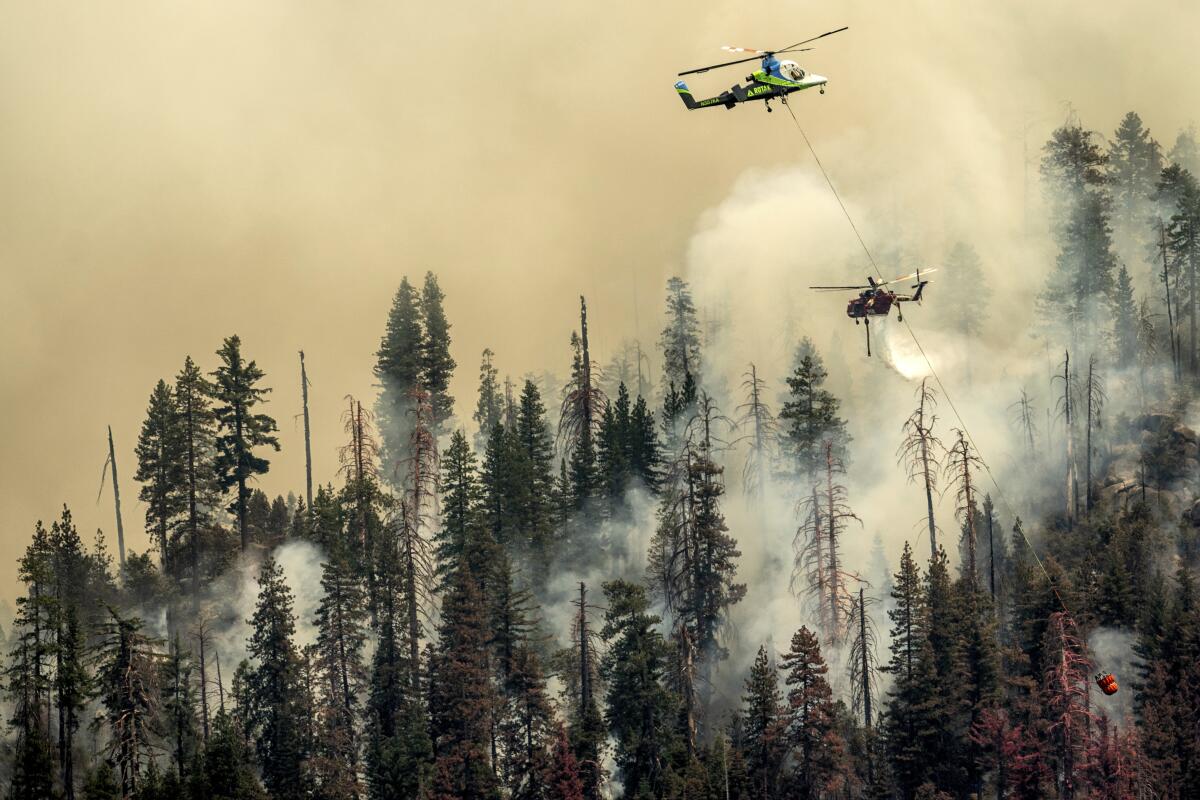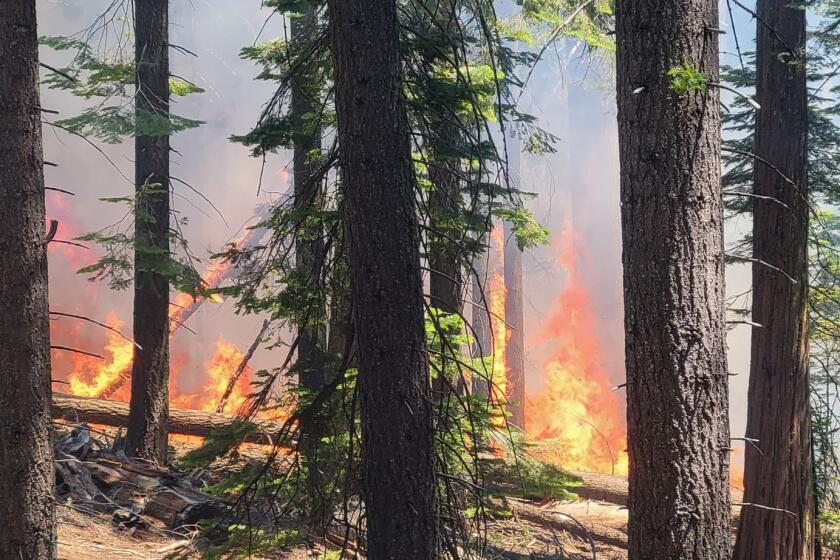Hotter, drier conditions heighten danger as Yosemite fire threatens ancient sequoias

- Share via
A fire threatening hundreds of ancient sequoias in Yosemite National Park continued to spread Sunday as firefighters braced for more difficult conditions this week with warmer and drier weather approaching.
The Washburn fire had grown to at least 2,044 acres by Sunday evening and was burning on the southern end of the park near the historic Mariposa Grove, home to about 500 giant sequoias, officials said. The blaze is also threatening the community of Wawona and prompted officials to close Highway 41 near the south entrance to Henness Ridge Road.
Fire officials said that rising temperatures and dry weather were predicted for much of the week, creating the potential for flames to spread quicker and making an already difficult task even more challenging for crews fighting the blaze.
“Today is turning out to be hotter and drier,” U.S. Forest Service spokesman Stanley Bercovitz told The Times. “That makes conditions harder for the firefighters and better for burning, unfortunately.”
He added, however, that the “saving grace” is that winds are not high, which has helped keep the flames from fanning out more quickly.
More than 545 firefighters were battling the blaze in a coordinated land and air attack, officials said. But Bercovitz said that thousands more from across the country are being called in. In the case of major fires with valuable assets at risk, such as homes or ancient groves, reinforcements typically are summonedfrom Oregon and Washington before their fire season has started and from Alaska, Arizona and New Mexico after their fires begin to die down. But because fire seasons everywhere are lasting longer, he said, it’s getting more difficulty to secure help.
“It’s turning into a logistical nightmare to get people to work for a long season,” he said. “But the orders are out now and it’s just a matter of getting the resources.”
He added that the current deployment of 11 water-dropping helicopters and multiple air tankers would also grow.
In the Mariposa Grove, crews were scraping the ground cover to bare soil to prevent flames and spot fires from spreading, and were installing portable sprinkler systems to spray the trees and increase humidity.
Firefightersset up a sprinkler system to water down the famed Grizzly Giant, which is more than 200 feet tall and one of the largest sequoias in the park.
The Washburn fire in Yosemite National Park was threatening some 500 giant sequoias, along with the community of Wawona.
“The fire is burning in difficult terrain with continuous fuels,” posing a “significant threat to firefighters,” fire officials said in a statement.
On Saturday, intense smoke and flames sent embers and fire debris hundreds of feet into the air, nearly striking an aircraft that was battling the blaze, according to radio traffic from the firefight.
“A branch went over the top of us,” the pilot reported to dispatchers. “Pretty good size, probably 50 feet above us coming down and fell right between tanker 103 and myself.”
“OK, copy. So like a repeat of yesterday,” a dispatcher said.
“That’s exactly what I’m getting at,” the pilot responded. “So if we keep seeing that, we might have to knock it off. I don’t want to take a chance of busting a window on an airplane or hurting an aircraft for this.”
Officials said Sunday that Yosemite remains open and visitors are advised to enter the park using highways 140 or 120, officials said.
News about the famous park and its threatened ancient sequoias has been followed globally, with around-the-clock media calls from Europe and Asia, Bercovitz said.
Last year was a devastating fire season for the sequoias after twin wildfires destroyed about 3,600 of the ancient trees as flames sparked by lightning strikes tore through more than two dozen groves in Northern California, National Park Service officials said.
The loss was stunning and equaled roughly 3% to 5% of the world’s sequoia population, officials said in a briefing last year after the KNP Complex and Windy fires. Ancient sequoias, with thick bark and massive canopies, can withstand low-intensity fire, and even need it to reproduce. But the giant trees are no match for intense wildfires fueled by climate change and years of drought.
The Washburn fire was the latest to ravage the western slopes of the Sierra Nevada. The heavily forested region has been battered by years of drought and decades of aggressive fire suppression, which has resulted in dense vegetation in some areas.
Located in the southern portion of Yosemite, the Mariposa Grove is the largest sequoia grove in the park and is historically significant. The concept of national parks is rooted in the grove. In 1864, President Lincoln signed legislation protecting the Mariposa Grove and Yosemite Valley for “public use, resort, and recreation.” It marked the first time that the federal government set aside scenic natural areas to be protected for the benefit of future generations.
Fire officials noted that a history of prescribed burns in the Mariposa Grove, along with scars from recent burns, could slow fire spread and limit potential damage.
“Once the fire reaches some of the recent fire scars, spread may slow,” officials said.
Staff writer Teresa Watanabe contributed to this report.
More to Read
Sign up for Essential California
The most important California stories and recommendations in your inbox every morning.
You may occasionally receive promotional content from the Los Angeles Times.












